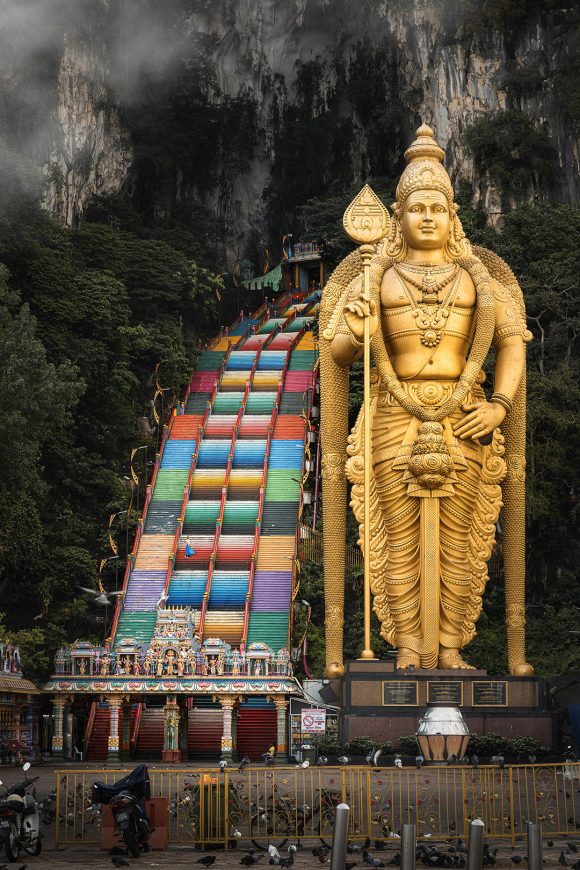
Batu Caves Photography Guide
The giant gold-plated statue of Lord Murugan, the Hindu god of war, that stands guard at the entrance to the Batu Caves is easily the most recognisably identifiable aspect of the temple complex. The 272 steps to the caves’ summit reward visitors with breathtaking panoramas of the forest and the city below.
The Batu Caves are not only important to the local religion and culture but also to rock climbers. Climbers of all skill levels will find a challenge in the tall limestone cliffs.
The Batu Caves should be on anyone’s list of must-sees while in Kuala Lumpur. In addition to learning about Hinduism’s long and storied past, you can enjoy spectacular scenery and try your hand at rock climbing. This is something you definitely shouldn’t miss out on!
When to go to Batu Caves?
Best time to visit to visit Batu Caves
The ideal time to visit the Batu Caves is definitely early in the morning on weekdays to avoid crowds and have a more calm experience. On weekends and holidays, especially during festive seasons when Hindu devotees come to pay their respects, the caverns can become rather busy.
If you wish to see some of the spectacular Hindu festivities and festivals that take place at the Batu Caves, you should organise your visit around one of these events. Thaipusam, a key festival in the Tamil calendar, is an especially magnificent display, with believers marching through the streets of Kuala Lumpur before ascending to the caverns.
Overall, the dry season, which lasts from February to September, is the greatest time to visit the Batu Caves. During this season, the weather is cooler and more comfortable, making it simpler to climb the steps to the top of the caves and tour the many temples and shrines. Whatever time of year you come, the Batu Caves will undoubtedly be a highlight of your journey to Kuala Lumpur.
How to get to Batu Caves?
Best ways to get to Batu Caves
Taking the KTM Komuter train from KL Sentral station is one of the simplest and most cost-effective solutions. The train travel takes around 30 minutes, and the Batu Caves station is the line’s final stop. It’s only a short walk from there to the caves themselves.
A taxi or ride-sharing service, such as Grab or Uber, is another alternative. If you’re in a hurry or travelling with a large group, this can be a convenient alternative because you won’t have to worry about arranging with a train schedule. However, because to the high volume of traffic in Kuala Lumpur, this method may take longer and be more expensive.
If you’re feeling particularly daring, you can rent a car and drive yourself to the Batu Caves. This gives you more freedom and control over your route, but be careful of local traffic restrictions and be prepared for congested roads.
Best photo spots at Batu Caves
Best photography locations in Kuala Lumpur
The Batu Caves are a breathtakingly spectacular place with numerous photographic opportunities. The distinctive gold-plated statue of Lord Murugan and the colourful stairs can be found at the entryway. When you reach the top, there are a number of temples and shrines to explore. Each has its own distinct vibe and photographic opportunity. Take your time and search for unique angles and compositions.
Entry Stairs
Best photo spots at Batu Caves

- Exact location: 3°14’13.6″N 101°41’00.7″E
- It depends on the perspective and your lens which exact position and angle you take.
- Use a tripod, if you have one and read photo tips below.
Great Place
Best photo spots at Batu Caves

- Exact location: 3°14’14.6″N 101°41’01.3″E
- Just stroll around and use the surroundings as great colorful background for your shots.
How to remove people from the shots?
Photo Tips for Batu Caves
You ask yourself: “How empty are the stairs in the photographs?” Even if you arrive early in the morning, there are people strolling around the stairs. So as long as the stairs are not closed for your photo-shoot, you will always have people in your shots. To get them removed quickly, I recommend the photo stacking method. Photo stacking is a technique used in photo editing to remove unwanted elements from an image, such as people. The process involves taking multiple photos of the same scene, with the unwanted element(s) in different positions in each photo. The photos are then combined using software that aligns and blends the images together, effectively “stacking” them. The final image will be a composite of the multiple photos, but without the unwanted elements.


- Setup your camera on a tripod and keep it stable.
- Take multiple photographs of the same scene on the tripod over a period of a few minutes. I recommend to take a shot every few seconds. You can do it manually because the shots do no need to be taken in the same time interval.
- Import all of the photos into a photo editing software that supports image stacking, such as Adobe Photoshop.
- Use the “Align Layers” or “Auto-Align Layers” function to align the images and blend them together, because sometimes there are still small movements, even on a tripod.
- You can use the automatic way, which does not always work. In this case, mark all auto-aligned layers and create a “Smart Object” by selecting all layers, right-clicking, and pressing “Create Smart Object”. Then go to “Layer”, “Smart Object”, “Stack Mode” and select finally “Mean Stack”.
- I prefer the manual edit, where I use layer masks to remove unwanted people. Move your main frame to the top and move each layer one by one on top of your main layer. Add a layer mask and fill it with black to remove the content. Remove the density of the layer mask a bit to make the layer slightly visible again. Then paint with white on the layer mask over the people, which can be replaced with parts of the stairs. If you took as many parts as possible from your layer, increase the density again to 100%. Repeat this with another layer until all unwanted people are removed.
Note that this method only works, if the stairs are not full of people. If you can’t see the stairs at all during the day, it will be difficult to remove all of the people. So come in the early morning, and you will only have to remove a few people (if you want).
How to be in the shot as couple?
Photo Tips for Batu Caves
To get both of you in one shot without further assistance, use the same technique described above. We had no help to take our couple shot which you can see above. This is how we took the shot:
- Setup your camera on a tripod and keep it stable. Emmy went up the stairs while I was waiting at the camera.
- I took multiple shots of Emmy in different poses.
- After Emmy came back, we changed positions. I went up the stairs, and Emmy was taking the shots.
- On the PC, I stacked the photographs that were the most consistent.


Opening Hours: 06:00 – 21:00
Entrance Fee: no fee / donation
Best time: Dry season (February to September) during week-days the early morning, due to massive crowds
Homepage: –
Photography Equipment: Tripod highly recommended












One comment